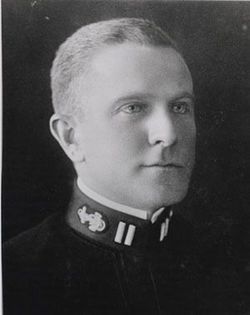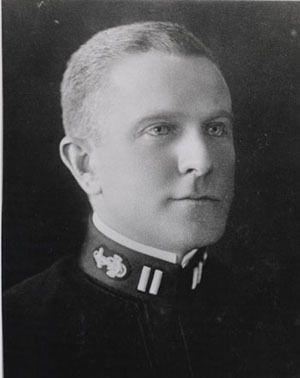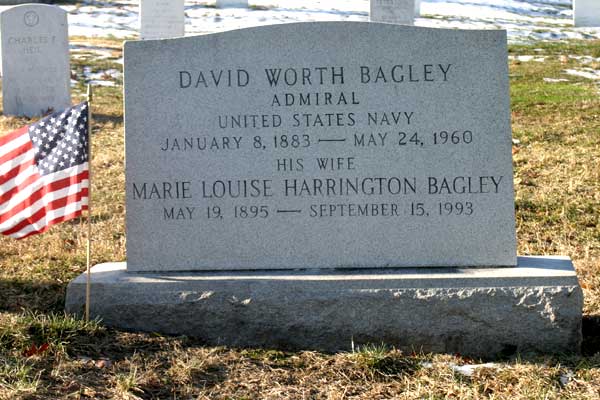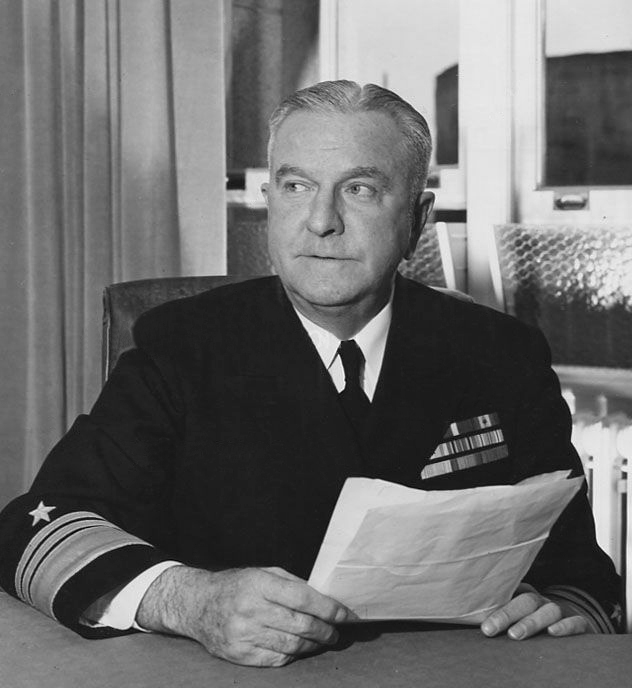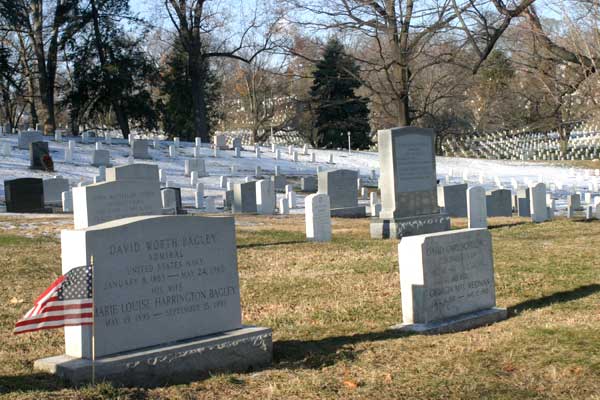United States Navy Admiral. His military career spanned World Wars I and II and he served in command positions the Pacific Theater of operations during World War II. After completing high school, he attended North Carolina State College, now known as North Carolina State University, in Raleigh, North Carolina in 1898 and 1899 before entering the United States Naval Academy at Annapolis, Maryland in 1900. Upon graduating in February 1904, he went to sea on the battleship USS Missouri, attached to the North Atlantic Fleet. In December 1905 he was reassigned to the Asiatic Fleet and served successively on the gunboat USS Concord and armored cruiser USS West Virginia. While serving on the USS Concord, he was commissioned an ensign in February 1906. He was detached from the USS West Virginia in March 1907 and the following year he was assigned to the battleship USS Rhode Island of the Atlantic Fleet and made the voyage around the world with her in the Great White Fleet. In April 1909 he went to the General Electric Company in Schenectady, New York for a year of instruction and in April 1910 he became aide and flag lieutenant to the Commander, 2nd Division, Atlantic Fleet. After a similar tour of duty on the staff of the Commander in Chief, Asiatic Fleet, he reported for duty at the United States Naval Academy in September 1912. Two years later he returned to sea as a first lieutenant on the battleship USS Michigan with the Atlantic Fleet. In September 1915 he became commander of the destroyer USS Drayton. In January 1917 he transferred to the destroyer USS Jacob Jones and was soon participating in antisubmarine patrols and convoy escort missions in the western approaches to the British Isles, the Irish Sea and the English Channel, when the United States entered World War I. On December 6, 1917, the Jacob Jones was struck by a torpedo and it sank within eight minutes carrying 64 crewmen with her. He and 37 others made it into the icy water in boats and on rafts and they were rescued two days later. He then returned to the United States and became the prospective commanding officer of the destroyer USS Lea, then under construction at the Philadelphia Navy Yard in Philadelphia, Pennsylvania. He put her into commission on October 2, 1918 and commanded her until January 1919 when he became the American port officer at Rotterdam, Netherlands with additional duty as the assistant naval attaché in the American legation at The Hague. In 1921 he returned to the United States for a tour of duty in the Office of Naval Intelligence, Washington D.C. The following year he returned to sea in command of the destroyer USS Reno and as Commander, Destroyer Division 32, Pacific Fleet. In August 1923 he transferred to command of Division 35, Destroyer Squadrons, Battle Fleet and in May 1924 he returned to the United States for another tour of duty at the United States Naval Academy. In 1926, at the end of the academic year, he became the chief of staff to the Commander, Naval Forces, Europe. In April 1927, he was reassigned to the 9th Naval District as the assistant (later changed to chief of staff) to the commandant with temporary additional duty as acting commanding officer of the Naval Training Station, Great Lakes, in Illinois. He returned to sea in December 1931 as commanding officer of heavy cruiser USS Pensacola, then serving in the Atlantic with Cruiser Division 4, Scouting Fleet. In May 1933 he returned to Washington D.C. for duty in the Bureau of Navigation, later becoming the assistant bureau chief. Two years later he attended the Naval War College at Newport, Rhode Island and after completing the senior course, he remained there as a member of the staff. This was followed by a year of duty as Commander, Destroyer Squadron 20, Destroyers, Scouting Fleet. From July 1937 until May 1938 he served as Commander Minecraft, Battle Force and while in that position, he was promoted to the rank of rear admiral and in May 1938 he became Commandant, Mare Island Navy Yard, in Vallejo, California. In January 1941, he broke his flag on the battleship USS Tennessee, as Commander, Battleship Division 2 and was serving in that position when his flagship was slightly damaged during the Japanese surprise air raid on Pearl Harbor, Hawaii, December 7, 1941. The following April he became Commandant, 14th Naval District and Commander, Hawaiian Sea Frontier, at Pearl Harbor and served in that capacity until January 1943. The following month he assumed command of the Western Sea Frontier and in March 1943, added the duties of Commandant, 11th Naval District, holding it until January 1944, but continued to head the Western Sea Frontier until the following fall. In February 1944 he was promoted to the rank of vice admiral and in November 1944 he became Commandant, 14th Naval District and served in that position until July 1945. In August 1945 he returned to Washington D.C. and was assigned to the Office of the Chief of Naval Operations and served on the International Defense Board, the United States-Mexican Defense Commission and the Permanent Joint Board on Defense and retired in March 1946 with 42 years of continuous military service. His military award and decorations included the Navy Distinguished Service Medal, the Legion of Merit, the World War I Victory Medal with Destroyer Clasp, the American Defense Service Medal with Fleet Clasp, the American Campaign Medal, the Asiatic-Pacific Campaign Medal and the World War II Victory Medal. His foreign awards and decorations included the Spanish Cruz del Mérito Naval Blanco de 2a Clase, the Portuguese Order of Avis and Greek Commander of the Order of the Savior by the Government. In April 1947 he was promoted to the rank of admiral on the retired list for having been especially commended in combat in accordance with an Act of Congress passed on March 4, 1925 and February 23, 1942 (colloquially known as a tombstone promotion). He died at the age of 77. He was the brother of Ensign Worth Bagley, who was the first American and Naval officer killed in action during the Spanish-American War.
United States Navy Admiral. His military career spanned World Wars I and II and he served in command positions the Pacific Theater of operations during World War II. After completing high school, he attended North Carolina State College, now known as North Carolina State University, in Raleigh, North Carolina in 1898 and 1899 before entering the United States Naval Academy at Annapolis, Maryland in 1900. Upon graduating in February 1904, he went to sea on the battleship USS Missouri, attached to the North Atlantic Fleet. In December 1905 he was reassigned to the Asiatic Fleet and served successively on the gunboat USS Concord and armored cruiser USS West Virginia. While serving on the USS Concord, he was commissioned an ensign in February 1906. He was detached from the USS West Virginia in March 1907 and the following year he was assigned to the battleship USS Rhode Island of the Atlantic Fleet and made the voyage around the world with her in the Great White Fleet. In April 1909 he went to the General Electric Company in Schenectady, New York for a year of instruction and in April 1910 he became aide and flag lieutenant to the Commander, 2nd Division, Atlantic Fleet. After a similar tour of duty on the staff of the Commander in Chief, Asiatic Fleet, he reported for duty at the United States Naval Academy in September 1912. Two years later he returned to sea as a first lieutenant on the battleship USS Michigan with the Atlantic Fleet. In September 1915 he became commander of the destroyer USS Drayton. In January 1917 he transferred to the destroyer USS Jacob Jones and was soon participating in antisubmarine patrols and convoy escort missions in the western approaches to the British Isles, the Irish Sea and the English Channel, when the United States entered World War I. On December 6, 1917, the Jacob Jones was struck by a torpedo and it sank within eight minutes carrying 64 crewmen with her. He and 37 others made it into the icy water in boats and on rafts and they were rescued two days later. He then returned to the United States and became the prospective commanding officer of the destroyer USS Lea, then under construction at the Philadelphia Navy Yard in Philadelphia, Pennsylvania. He put her into commission on October 2, 1918 and commanded her until January 1919 when he became the American port officer at Rotterdam, Netherlands with additional duty as the assistant naval attaché in the American legation at The Hague. In 1921 he returned to the United States for a tour of duty in the Office of Naval Intelligence, Washington D.C. The following year he returned to sea in command of the destroyer USS Reno and as Commander, Destroyer Division 32, Pacific Fleet. In August 1923 he transferred to command of Division 35, Destroyer Squadrons, Battle Fleet and in May 1924 he returned to the United States for another tour of duty at the United States Naval Academy. In 1926, at the end of the academic year, he became the chief of staff to the Commander, Naval Forces, Europe. In April 1927, he was reassigned to the 9th Naval District as the assistant (later changed to chief of staff) to the commandant with temporary additional duty as acting commanding officer of the Naval Training Station, Great Lakes, in Illinois. He returned to sea in December 1931 as commanding officer of heavy cruiser USS Pensacola, then serving in the Atlantic with Cruiser Division 4, Scouting Fleet. In May 1933 he returned to Washington D.C. for duty in the Bureau of Navigation, later becoming the assistant bureau chief. Two years later he attended the Naval War College at Newport, Rhode Island and after completing the senior course, he remained there as a member of the staff. This was followed by a year of duty as Commander, Destroyer Squadron 20, Destroyers, Scouting Fleet. From July 1937 until May 1938 he served as Commander Minecraft, Battle Force and while in that position, he was promoted to the rank of rear admiral and in May 1938 he became Commandant, Mare Island Navy Yard, in Vallejo, California. In January 1941, he broke his flag on the battleship USS Tennessee, as Commander, Battleship Division 2 and was serving in that position when his flagship was slightly damaged during the Japanese surprise air raid on Pearl Harbor, Hawaii, December 7, 1941. The following April he became Commandant, 14th Naval District and Commander, Hawaiian Sea Frontier, at Pearl Harbor and served in that capacity until January 1943. The following month he assumed command of the Western Sea Frontier and in March 1943, added the duties of Commandant, 11th Naval District, holding it until January 1944, but continued to head the Western Sea Frontier until the following fall. In February 1944 he was promoted to the rank of vice admiral and in November 1944 he became Commandant, 14th Naval District and served in that position until July 1945. In August 1945 he returned to Washington D.C. and was assigned to the Office of the Chief of Naval Operations and served on the International Defense Board, the United States-Mexican Defense Commission and the Permanent Joint Board on Defense and retired in March 1946 with 42 years of continuous military service. His military award and decorations included the Navy Distinguished Service Medal, the Legion of Merit, the World War I Victory Medal with Destroyer Clasp, the American Defense Service Medal with Fleet Clasp, the American Campaign Medal, the Asiatic-Pacific Campaign Medal and the World War II Victory Medal. His foreign awards and decorations included the Spanish Cruz del Mérito Naval Blanco de 2a Clase, the Portuguese Order of Avis and Greek Commander of the Order of the Savior by the Government. In April 1947 he was promoted to the rank of admiral on the retired list for having been especially commended in combat in accordance with an Act of Congress passed on March 4, 1925 and February 23, 1942 (colloquially known as a tombstone promotion). He died at the age of 77. He was the brother of Ensign Worth Bagley, who was the first American and Naval officer killed in action during the Spanish-American War.
Bio by: William Bjornstad
Family Members
Sponsored by Ancestry
Advertisement
Explore more
Sponsored by Ancestry
Advertisement
